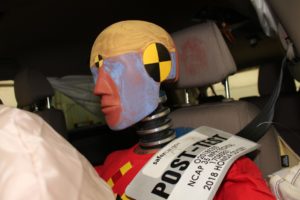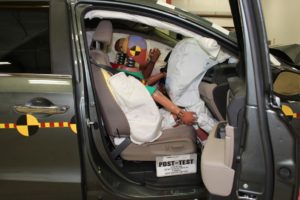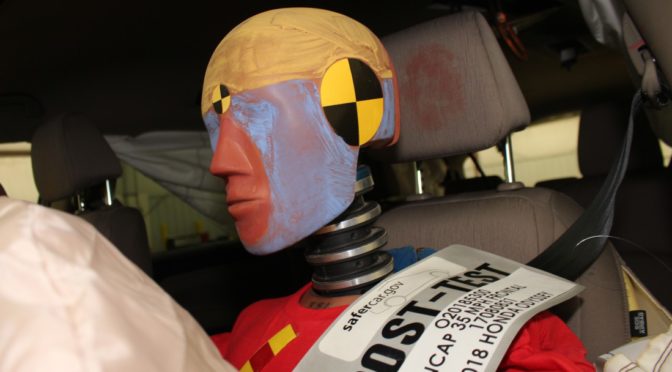
Crashes are frightening, even when we have time to anticipate them. They break our illusions of a world within our control and remind us–if we’re lucky enough to live through them–of just how vulnerable we are. Unfortunately, even with a fundamental knowledge of best practices in driver safety, it’s all-too-easy to find ourselves in situations where we make the wrong decisions under stress. Today we’re going to look at a tragic example of why you should (almost) never leave your car, minivan, SUV, or pickup truck after a highway collision.
Why shouldn’t you leave your vehicle after a highway collision?

Let’s say you were just in a crash. More specifically, let’s say you were driving down a two-lane undivided highway (a bad idea) at night (another bad idea) and speeding (yet another bad idea) in winter without winter tires (you get where this is going). Perhaps you’ve also been drinking (one more bad idea), since it was New Year’s Day (or any other holiday where drunk driving rates increase). And for good measure, let’s say you’re tired (which, just like every other risk factor above, impairs your judgment). At this point, it might be a miracle you’re still on the road and in your lane.
Let’s say you leave your lane.
And you drive into the path of another vehicle.
And before you have time to react (keep in mind how quickly you cover distance before you can react, and how much more distance you need for your brakes to bring you to a stop), you hit that vehicle in a head-on collision. Per Vision Zero, if that collision occurred at above 43 mph (which it almost certainly did, since undivided highways in the US typically have 55 mph+ speed limits), there’s a good chance, statistically, that someone’s going to die. And someone does. Out of you, the driver, and front-seat passenger in the other vehicle, the other driver dies immediately.
You, however, survive. You survive well enough (due to the design of your vehicle, perhaps) to open the door, conscious, and leave your vehicle. It’s in the middle of the road with the other vehicle, and you walk to the side of the road in the dark and try to orient yourself to what just happened. Maybe you start trying to figure out where your phone is so you can call for help. Maybe you’re just trying to catch your breath because you’re crying and in shock and freezing; it’s the middle of the night in January, after all.
All of a sudden, night turns into day–except it’s not daytime. It’s another car coming down the highway (also speeding, in all likelihood). At this point, you’re a pedestrian. Your odds of being hit by a vehicle and surviving drop from 95% at 20 mph to 5% at 40 mph.
The speed limit, once again, is at least 55 mph, and most people speed.
The driver doesn’t see you. The driver does see the vehicles in the middle of the road, but due to a combination of the aforementioned factors (speeding, darkness, inappropriate tires, fatigue) can’t stop in time, and swerves off the side of the road…
…right into you. And everything goes black. Forever.
If you don’t get far enough off the highway, you have a high chance of being killed by a passing vehicle
If this sounds like a nightmare, it’s because it is. But it also happened, as best as we can tell, somewhat like the dramatization above, on New Year’s Day in 2018. The town was Milton, the highway was 59, and the people involved were Kelsea Ann Anderson, 23, and Tracy Ann Stolen, 34. Anderson drove a 2011-era Jeep Grand Cherokee northbound somewhere around 3:30 AM when she left her lane and crashed into Stolen, who was southbound in a Chrysler Town & Country. Miguel C. Baladez, 26, a passenger in the van, survived the crash and was hospitalized in stable condition.
Anderson survived the crash, left the vehicle, stood by the gravel shoulder, and was soon hit by 30-year old Andrew Kuehne driving a GMC Acadia. Kuehne, who was driving to work, saw the crash, believed he could not stop in time, swerved to avoid it, and hit Anderson, who died after being taken to a hospital. Investigators have suggested Anderson had been drinking.
To increase your chances of survival after a high-speed crash, stay in your vehicle unless it’s on fire or sinking

Your odds of survival while ensconced in a multi-ton vehicle–even a damaged one–are far, far greater than your odds of survival on the side of the road if you’re about to be hit by another multi-ton vehicle at high speeds. While it goes against our instincts to get off the road or get away from the crash, I’d recommend remaining in your vehicle unless it presents an imminent danger to do so.
As this tragic story indicates, drivers are more likely to swerve off the road to avoid vehicles in the road than they are to hit said vehicles in the road. If you’re in a large, heavy target, other drivers will avoid you out of self-preservation, if for no other reason. If you’re a human-sized object on the side of the road and conditions are less than perfect–weather-wise or in terms of the mental states of the drivers approaching you–you’re at far greater odds of being hit than anything else.
Stay inside to stay alive.
Stay inside to stay alive. It’s short, it’s simple, and in most cases, it’s true. It’s even easier to do if your vehicle isn’t in the middle of the road after a crash or flat tire. Even if it is, however, it’s still going to be better than being just a few feet away from your vehicle. I’ve read too many cases of people surviving crashes, just as Anderson did, only to be killed by other drivers who directly hit them or who hit their vehicles–the vehicles that just saved their lives–driving their vehicles into them as they stood beside their vehicles.
Stay inside to stay alive.
Mike, why do you call these situations crashes or collisions instead of accidents?

This is a question I get from time to time. The reason i refer to crashes as “collisions” or “crashes” is because in auto safety circles, they’re typically not referred to as accidents, because even though we almost never mean for them to occur, they’re almost always preventable. An accident implies that whatever event occurred did so due to an act of God. In reality, whatever event occurred typically did so due to a combination of factors, including speeding, alcohol consumption, a lack of seat belt use, a lack of attention, fatigue, cell phone use, a lack of winter tires, road rage, etc.
A full 50% of auto fatalities occur by people who simply run off the road into trees, bridges, barricades, telephone poles, walls, and other barriers. It’s a semantic difference in many respects, but it does help shift the locus of control back toward the individual and society (e.g., driving techniques, vehicle safety, road design) rather than toward fate, which, by definition, cannot be altered. There’s nothing to learn from when we decide that bad things happen purely due to chance; we need to take ownership of our roles as individuals and societies in creating road traffic that respects human life.
Read more about best practices in driving techniques, vehicle safety, and road design here
 If you find my information on best practices in car and car seat safety helpful, you can buy my books here or do your shopping through this Amazon link. Canadians can shop here for Canadian purchases. Have a question or want to discuss best practices? Send me an email at carcrashdetective [at] gmail [dot] com.
If you find my information on best practices in car and car seat safety helpful, you can buy my books here or do your shopping through this Amazon link. Canadians can shop here for Canadian purchases. Have a question or want to discuss best practices? Send me an email at carcrashdetective [at] gmail [dot] com.

